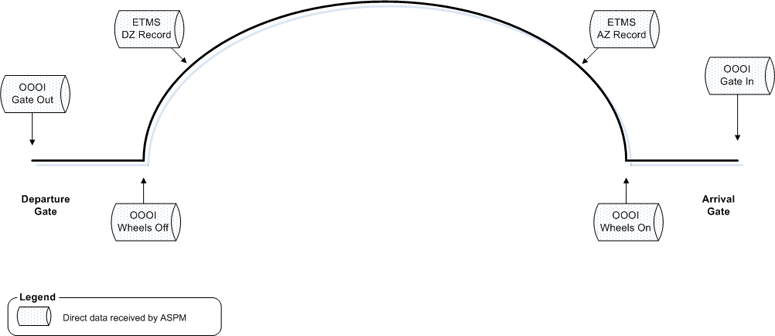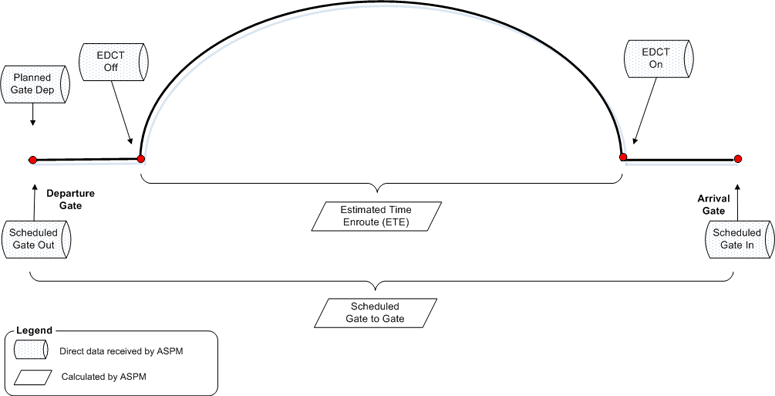ASPM:Flight Level
Contents |
Introduction
The Individual Flight is the basic component of ASPM analysis calculations.
Actual Times (OOOI & TFMS)
ASPM begins by collecting actual points in time for flights. All points in time are stored in ASPM as GMT Seconds Since 1980, or "GMT Seconds". ASPM uses GMT Seconds to make duration calculations easy. When times are displayed, they are converted to local time. The following graphic indicates the actual (observed) points in time that ASPM collects along the path of a typical flight. The two sources of this data are either OOOI Data or TFMS.
OOOI data (Gate Out, Wheels Off, Wheels On, and Gate In, or Out-Off-On-In), is collected from electronic devices in aircraft from major carriers. This data are provided to ASPM for many carriers by the OAG (starting FY16) and supplemented for select carriers through a cooperative agreement with the FAA (on a next day basis), and/or from the ASQP data published monthly by DOT. In addition, since October 1, 2012, an extract of the FAA Offload system called CountOps provides next day On and Off times derived from aircraft radar tracking data.
TFMS data comes from the FAA's Air Traffic Control system and contains a wealth of information. The graphic below is only looking at the actual times used by ASPM. (TFMS TZ messages report Enroute Center RADAR hits and generally occur 5 minutes apart. These are not directly used in ASPM calculations until much later.)
ASPM focuses on all air traffic to and from the ASPM 77 airports plus all flights to and from U.S. airports by the ASPM carriers. These top carriers serve many international destinations, so many international flights are present in ASPM.
Flight Level Calculations
The following image illustrates the ASPM calculations that naturally flow from the several time observations from OOOI and/or TFMS data. ASPM calculates all durations in minutes.
ASPM uses four sources of OOOI data. OAG OOOI (starting in FY16) and TFMS (starting in FY15) provide next day Out, Off, On, and In data for approximately 82% of flights at the 77 ASPM airports. Since October 2012, CountOps also provides On and Off data on a next day basis, resulting in next day actual On and Off times for nearly all flights at those airports. In addition, ASQP data, which is typically transmitted by DOT and loaded into ASPM 40 days after the end of the month, provides official OOOI data for the ASQP Carriers.
The actual times calculated here are used to help estimate OOOI times for flights where OOOI times are missing (more on this under ASPM: Estimation Techniques ).
Scheduled and Planned Times
The following image illustrates the Scheduled and Planned times that ASPM collects. Using Scheduled and Planned times allows ASPM to calculate delays.
Scheduled Times are generally flight times published well in advance of the day of a specific flight. This time typically comes from an official source of schedule information, currently provided by Innovata, a private aviation data supplier, and in the case of ASQP Data, from the Computer Reservations System (CRS). Scheduled Times provide a good reference point from the point of view of the passenger.
Planned Times come from the filed flight plan for each flight. These Planned Times are required to be no more than 24 hours in advance and be updated if the planned times are more than an hour off. Planned Times provide a good reference point for how each flight is handled once it is ready to depart.
There are many other planned times used by ATC which are reported in TFMS. For example, the ATC estimates planned wheels off and on times to assist with traffic management. ASPM focuses on the times depicted here as sufficient for the ASPM model.
EDCT Times are only present when a Traffic Management Initiative such as a Ground Delay Program or Airspace Flow Program is in effect, which requires aircraft to be held on the ground at the departure airport. If a destination airport or en route airspace is expected to be congested due to weather or other factors, the ATCSCC or facility will initiate a GDP or AFP that holds flights at the departing airport. For example, when a severe thunderstorm disrupts traffic, aircraft may be held on the ground at the departing airport until they can be safely accommodated on the arrival side.
ASPM calculates delays using both Scheduled and Planned times as reference points to provide a more complete picture of the Air Traffic Control System's operation and performance.




